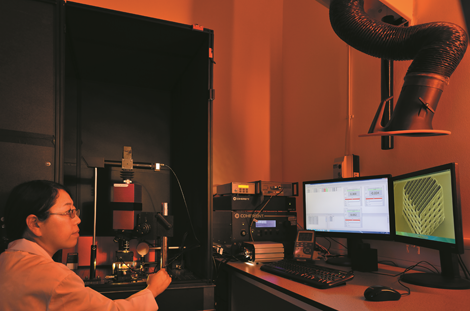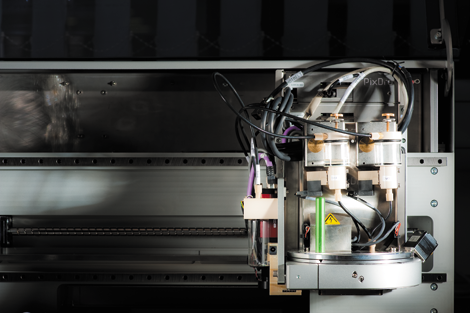
The lab hopes to develop new materials for nano fabrication of multifunctional systems
A £2.7m grant from the Engineering and Physical Sciences Research Council (EPSRC) has funded new facilities and state-of-the art bespoke machines for The University of Nottingham.
The Additive Manufacturing and 3D Printing Research Group based at the university is now looking to drive 3D printing applications from medical uses to printing multiple functional materials as conductive metals and semiconductors, all in one go, on a single machine.
The lab’s capabilities are based around three flagship pieces of technology:

A Pixdro JetX in action
– A bespoke Pixdro JetX six head ink jetting system by Roth & Rau, which can print structural and functional materials (such as electronic circuits/components for circuit boards) in one go, using up to six different materials at once including metallic and ceramic loaded ‘inks’ as well as a variety of reactive polymers.
Each print layer can be custom designed with the machine’s custom design software. This technology will enable the manufacture of 3D printed electronics without the need for multiple machines.
The machine will also be used to research and test ‘3D printed drugs’, combining the exact dosage of each ingredient into every individual pill, capsule or vaccine based on an individual’s requirements.
– A two-photon lithography system from Nanoscribe, which is capable of printing polymer-based 3D objects with heights from a few hundred nanometres up to the mesoscale. This machine will be used in the lab for industrial applications such as printing and replicating micro-lenses, micro antenna devices for smartphones as well as medical research.
The team will use the Nanoscribe machine for the development of new materials for nano fabrication of multifunctional systems.
3D printing on a nano-scale will open up new fields for additive manufacturing through the ability to fabricate very fine structures that are even smaller than cells that make up the human body.
– A bespoke metal-jetting system, developed in partnership with Demcon and Océ.
The only machine of its kind in the world, it will help refine and develop new metal printing processes for applications such as 3D electronics.
Its four print heads allow it to jet and print molten metal droplets of silver, tin and copper – as well as semi-conducting materials – at temperatures up to 1,800 degrees Celsius.
These capabilities will make the machine ideal for printing (mixed) metal 3D structures and functional electronics more easily and efficiently.
“This new lab and Added Scientific represent a huge step forward in additive manufacturing research and development. We aren’t about printing just shapes or creating objects for their own sake, but about using science and engineering to find new ways to apply additive manufacturing to the real world,” said Professor Richard Hague who leads 3DPRG and is director of the University’s EPSRC Centre for Innovative Manufacturing in Additive Manufacturing.
“The state-of-the-art equipment in our new lab will allow us to refine the process of multi-functional 3D printing, working with research organisations and industry partners to make 3D printed electronics, pharmaceuticals and conductive materials a safe, viable and cost-effective reality.”






